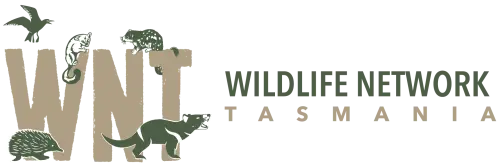Helping you understand Tasmania’s wildlife—and how you can help
If you come across a sick, injured or orphaned animal, keep it warm, quiet, and safe, and call Bonorong Wildlife Rescue on 0447 264 625 (24/7 statewide hotline). Avoid feeding or handling the animal more than necessary.
Click here to view the factsheet.
Yes! Tasmania needs more trained wildlife rehabilitators.
To start, you’ll need to complete an approved Introductory Mammals Course and apply for a permit from NRE Tas.
Wildlife Network Tasmania can help guide your journey and connect you with training, support, and community.
Wildlife rescuers assist with locating and transporting animals in need, while carers hold a permit and provide short or long-term care and rehabilitation.
Many people begin as rescuers before becoming full carers.
There are many ways to help! You can:
- Join WNT as a Supporter Member
- Donate or fundraise to help rehabilitators
- Volunteer in other ways, like transport, sewing pouches, or helping at events
- Spread the word to help reduce harm to wildlife on roads and in backyards
All donations go directly towards supporting Tasmania’s wildlife rehabilitation & rescue network.
This includes training carers, providing equipment and support, running workshops, improving wildlife outcomes, and building sector resilience.
We report transparently on how funds are used each year.
We are Tasmania’s peak body for wildlife rehabilitators and rescuers, working to support, connect, and advocate for the volunteer wildlife sector.
We run training programs, create support systems, and help build a more sustainable future for Tasmania’s native animals and the volunteers who care for them.
No.
While we receive government funding and collaborate with government bodies like NRE Tas, WNT is an independent not-for-profit organisation, run by volunteers, and exists to represent and support wildlife volunteers across the state.
Wildlife can only be released in appropriate, pre-approved locations.
WNT has built a Land Release Registry to help match carers with safe, species-suitable release sites across Tasmania.
Click here for more information.
Wildlife Rehabilitation Sector Strategy and Action Plan 2022-2024
The Wildlife Rehabilitation Sector Strategy and Action Plan is a community-driven initiative aiming to enhance wildlife rehabilitation in Tasmania. It aims to achieve this by:
- Offering consistent, high-quality training for all levels of wildlife rehabilitators.
- Recognising and nurturing the valuable skills of these rehabilitators, acknowledging their contribution to conservation efforts in Tasmania.
- Creating a strong partnership between rehabilitation and veterinary sectors, ensuring a unified and effective approach to wildlife rehabilitation.
- Engaging the Tasmanian community to appreciate and protect wildlife, securing Tasmania’s position as The Wildlife State.
The strategy and action plan also offer guidance for those interested in supporting the protection, rescue, and rehabilitation of injured or orphaned wildlife in Tasmania, even if they’re not currently involved. This document outlines opportunities for individuals and groups to get involved through volunteering, partnerships, donations, or by offering in-kind support.
A thorough community consultation process involving wildlife rehabilitators and various stakeholders commenced in 2021. This process identified vital components that are now the heart of our strategy and action plan, crucial for rehabilitators and the rehabilitation process. To support this plan, the Tasmanian government has dedicated $400,000 for its implementation over the next three years.
Through the consultations, we learned that many wildlife rehabilitators are feeling tired and overwhelmed. The entire sector is fragile, facing the risk of losing experienced rehabilitators if we don’t address some ongoing challenges.
We urgently need to make changes to support our dedicated volunteers in their crucial work. Key needs include:
- Improved wildlife coordination: Ensuring swift placement of injured animals with skilled rehabilitators.
- Accessible training: Providing affordable and accessible training to ease volunteers’ distress and ensure better care for wildlife.
- Veterinary access: Ensuring volunteers have access to wildlife veterinary services.
- Mentorship: Recruiting more mentors and offering additional training to support less experienced rehabilitators.
- Peer support: Establishing effective peer networks across Tasmania for sharing resources and knowledge.
- Financial aid: Providing financial support for volunteers’ expenses in caring for wildlife.
- Behaviour standards: Establishing expected behaviour and communication standards in the sector.
- Resources: Securing physical, practical, and financial resources crucial for the sector’s success.
It is crucial for the wildlife rehabilitation sector to have the right resources and support. This document details immediate steps to address these needs, and outlines our plans for future actions to create a more robust and sustainable sector.
- Guidance, Funding & Resourcing – A statewide implementation and guidance body to provide governance, strategic direction,and coordination across the sector, engage with the Tasmanian community, and secure sustainable funding and resourcing for the sector.
- Volunteer Support & Culture – We have a growing number of volunteers who are collaborative, positive, respectful and well-supported to ensure the best outcome for wildlife and their carers.
- Wildlife Rehabilitation Coordination – There is a smooth, seamless and timely process for the coordination of wildlife placement to facilitate the best outcomes for each individual animal, which may include immediate release, rehabilitation, or euthanasia.
- Standards of Care & Training – Our training covers all aspects of wildlife rehabilitation, including leadership and mentoring. Everyone has access to training and support to care for wildlife in accordance with evidence-based standards of care.
- Recruitment, Retention, & Succession Planning – We have a growing community of wildlife volunteers who have access to training and support which is visible, accessible and flexible. This in turn leads to positive outcomes for wildlife.
- Community Engagement – Tasmanians and visitors to our State value our wildlife, know how to prevent injury, know how to rescue injured and orphaned wildlife, and support the work of the sector.
- Positive Culture: We value diversity in the sector and provide a safe, respectful and inclusive working environment that fosters learning and cooperation.
- Collaboration & Knowledge-Sharing: We understand outcomes for injured and orphaned wildlife are enhanced through collaboration and knowledge-sharing between all participants in the sector.
- Best Practice: We recognise best practice rehabilitation is not static and will continually evolve with experience, new scientific research and community expectations.
- Continuous Improvement: We are open to and strive for continuous improvement in wildlife rehabilitation, from day-to-day rescue and care to wildlife emergency management.
- Community Education & Awareness: We play a pivotal role in helping the community to better understand the complexities of wildlife safety and rehabilitation.
- Strategy & Governance: We recognise the importance of effective sector-wide governance that defines clear roles and responsibilities that can deliver the agreed strategic outcomes.
The Tasmanian Wildlife Strategy & Action Plan 2022-2024 sets high goals. We’re dedicated to accomplishing all outlined objectives, yet our pace will rely on securing necessary support and resources. In 2024 we evaluated progress, adjust priorities, and set new goals, continuing our journey toward our long-term vision. The 2025-2030 strategy is currently being drafted for review.

